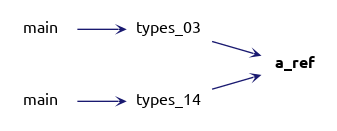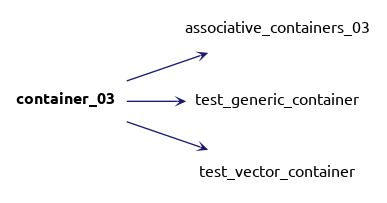Language
Collaboration diagram for Language:

Classes | |
| struct | Common |
| struct | Virtual_A |
| ref More... | |
| struct | Virtual_B |
| struct | Diamond |
Functions | |
| void | init_03 () |
| void | associative_containers_03 () |
| template<class C > | |
| void | test_generic_container (C &c) |
| template<class V > | |
| void | test_vector_container (V &v) |
| void | container_03 () |
| container More... | |
| void | sort_03 () |
| int & | a_ref (int &a) |
| https://en.cppreference.com/w/cpp/language/reference More... | |
| void | types_03 () |
Detailed Description
Function Documentation
◆ a_ref()
| int & a_ref | ( | int & | a | ) |
https://en.cppreference.com/w/cpp/language/reference
Definition at line 209 of file 03.cpp.
Here is the caller graph for this function:

◆ associative_containers_03()
| void associative_containers_03 | ( | ) |
◆ container_03()
| void container_03 | ( | ) |
◆ init_03()
◆ sort_03()
| void sort_03 | ( | ) |
http://www.cplusplus.com/reference/algorithm/sort/?kw=sort
Compare with lambda::sort_11 and sort_libc
Definition at line 184 of file 03.cpp.
Here is the caller graph for this function:

◆ test_generic_container()
template<class C >
| void test_generic_container | ( | C & | c | ) |
◆ test_vector_container()
template<class V >
| void test_vector_container | ( | V & | v | ) |
◆ types_03()
| void types_03 | ( | ) |
Definition at line 224 of file 03.cpp.
Definition: 03.cpp:220
Here is the call graph for this function:

Here is the caller graph for this function:






